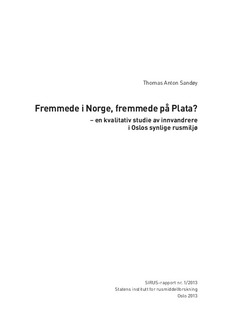| dc.contributor.author | Sandøy, Thomas Anton | |
| dc.date.accessioned | 2015-01-30T14:21:27Z | |
| dc.date.accessioned | 2015-02-11T20:24:38Z | |
| dc.date.available | 2015-01-30T14:21:27Z | |
| dc.date.available | 2015-02-11T20:24:38Z | |
| dc.date.issued | 2013 | |
| dc.identifier.citation | SIRUS-rapport. 125 p. Statens institutt for rusmiddelforskning, 2013 | |
| dc.identifier.isbn | 978–82–7171–397–3 | |
| dc.identifier.uri | http://hdl.handle.net/11250/276088 | |
| dc.description | - | |
| dc.description.abstract | Såkalte innvandrergjenger har blitt koblet til narkotikaomsetningen i Norge siden
70-tallet. Brukermiljøene har på sin side hovedsakelig bestått av etnisk norske.
Innvandrere spiller fortsatt en rolle på tilbydersiden, men befinner seg i dag i
økende grad på mottakersiden av narkotikatransaksjoner. Siden slutten av 90-tallet
har andelen innvandrere i Oslos synlige rusmiljø økt. Få studier er blitt gjort av det
som må sies å være en av de mest marginale gruppene i det norske samfunn. Dette
til tross for at det «nye» segmentet av rusmiddelmisbrukere vekker både oppsikt og
bekymring.
Denne rapporten handler om livshistoriene til 13 innvandrermenn med lang
fartstid i Norge, rusmiddel
misbruk og Oslos synlige rusmiljø. På intervju
tids
-
punktet oppholdt de seg på de åpne omsetningsstedene ved Oslo Sentralbane
-
stasjon, diverse lavterskeltilbud og hospitser.
Felles for de intervjuede er at de ankom Norge utenfra, bruker/brukte tunge
rusmidler og er/var en del av det synlige rusmiljøet i Oslo. Utover dette er det stor
variasjon i migrasjonshistorier, rusmiddelkarrierer og grad av tilknytning til
rusmiljøet. For å fange spennvidden i historiene ligger det en åpen tilnærming til
grunn for rapporten. Den studerer hvordan en gruppe innvandrere i Oslos synlige
rusmiljø selv forstår situasjonen de befinner seg i. Problemstillingene dreier seg om
tilhørighet til Norge, forklaringer på rusmiddelmisbruk og relasjon til rusmiljøet.
Samtlige av de intervjuede fremstiller opphavet, i form av røtter, tradisjoner og
kultur, som grunnleggende for eget liv. De er dypest sett utlendinger. Dette gjør
identifiseringen med det norske samfunn og «norskhet» ambivalent. De fleste er
glade over å befinne seg i Norge, men forteller samtidig om manglende eiendoms
-
forhold til landet. Til tross for at informantene behersker språket, antatt norske
væremåter og sosial omgang med nordmenn, opplever de at de aldri kan bli fullt ut
norske. På den annen side er språk, væremåter og kontakt med majoritets
-
befolkningen avgjørende for tilhørigheten til Norge. Informantene har oppholdt | |
| dc.description.abstract | So-called immigrant gangs have been linked to the drug trade in Norway since the 1970s. The user environments, on the other hand, have primarily consisted of ethnic Norwegians. While immigrants still play a role on the supply side, they are currently to be found in increasing numbers on the demand side of drug transactions. Since the late 1990s, the proportion of immigrants in Oslo's open drug scene has grown. Few studies have been conducted on what must be characterized as one of the most marginal social groups in Norway. The lack of studies is somewhat surprising, considering the general attention and concern this "new" segment of the substance abuse population attracts.
This report is about immigrants in the drug milieu. More specifically, it is about the life stories of 13 immigrant men, all with a long history of drug use and participation in the drug milieu in Oslo. The interviewees were recruited at the open drug scene by the Oslo Central Station, various low-threshold facilities and shelters.
What the interviewees have in common is that they immigrated to Norway, use/used heavy drugs, and are/were involved in the open drug scene on the streets of Oslo. Beyond this, their migration histories, drug careers and association with the drug milieu vary widely. So as to capture the breadth of their stories, an open approach forms the basis of this report. The report examines how a group of immigrants in the drug environment understand the situation in which they find themselves. The research issues touch on their sense of belonging in Norway, their reasons for using drugs, and their relations with the drug scene.
Origins in the form of roots, traditions and culture are fundamental in all of the life stories. The interviewees remain foreigners in essence. This makes their identification with Norwegian society and "norwegianness" ambivalent. Most are happy to live in Norway but lack any real sense of ownership to the country. And although they speak the language, act like and mix with Norwegians socially, they can never be fully Norwegian. On the other hand, knowledge of the language, of social conventions, and contact with the majority population are essential to a sense of belonging in Norway. The interviewees have lived in the country for many years and masters "norwegianness" in practice. For this reason their attachment to Norway would appear to be stronger than their own sense of identification would suggest. | |
| dc.language.iso | nob | |
| dc.relation.uri | http://www.sirus.no/filestore/Import_vedlegg/Vedlegg_publikasjon/sirusrap.1.13.pdf | |
| dc.title | Fremmede i Norge, fremmede på Plata? En kvalitativ studie av innvandrere i Oslos synlige rusmiljø | |
| dc.title.alternative | Strangers in Norway, strangers in the drug milieu? A qualitative study of immigrants in Oslo’s open drug scene | |
| dc.type | Research report | |
| dc.date.updated | 2015-01-30T14:21:27Z | |
| dc.identifier.cristin | 1069328 | |
